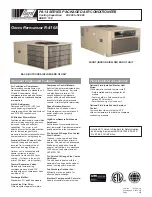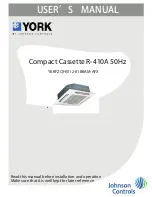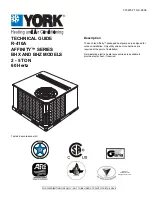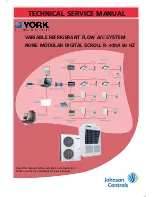
ECM Motors
UNT-SVX07E-EN
149
General Information
The VelociTach motor control board oversees and
monitors all motor operations and changes to speed
resulting from:
•
Direct fan speed requests
–
Customer fan speed switches
–
Thermostat fan speed, On or 0–10V requests
–
Automatic fan request from Tracer ZN / UC
controllers
•
Indirect fan speed requests
–
Electric heat requests will bring the fan to the
proper speed.
•
Conflicting fan speed requests
–
If two or more commands are received (direct or
indirect), the fan will honor the higher speed
requested.
Note:
In some cases, indirect requests will result in fan
behavior change regardless of whether the end-
device fails to actuate (due to device failure, or
safety/down-stream lockouts).
The VelociTach motor control board also coordinates the
operation of electric heat, electric/hydronic heat lockouts,
and CSTI changeover coil operation.
Troubleshooting Tips
•
VelociTach motor control board configuration must
perfectly match the factory-supplied ECM.
–
Refer to
“Adjustments,” page 92
for configuration of
the motor control board.
•
The VelociTach motor control board will display
troubleshooting information, and contains dual
tachometers to aid in performance verification.
•
Under normal circumstances, the VelociTach display
will display the operational status of the motors and
electric heat circuit/sensors, however, a malfunction
will drive a priority display mode that will present the
error code instantly to the screen. The error must be
cleared by solving by powering down, removing the
cause of the problem and restarting the engine board.
•
VelociTach label (see
“Motor control board label,”
page 98
) setup document (affixed to the back of the low
voltage access lid) should be used to verify engine
configuration settings.
•
For proper operation of the system, all plugs must be
firmly seated in all boards and motors. Insecure
connections will cause malfunction and the system
will shutdown.
•
Do not unplug or plug-in motors or connectors while
the system is receiving a speed request of any kind.
The system must be powered down before plugging or
un-plugging connections to the adapter boards,
engine boards or motors. Failure do so will register
diagnostics or cause unsafe operation and reduction in
the contact life of the connectors.
•
The motor will not spin if plugged in while the ECM
engine is requesting power.
Motor
The motor connections and motor plug connections to the
adapter boards should be secure. Unit should be powered
off to check the fit of the connectors.
When configured correctly, the system will always
respond positively to direct, indirect, and conflicting speed
requests with very few exceptions.
WARNING
Hazardous Voltage!
Failure to disconnect power before servicing could
result in death or serious injury. Disconnect all electric
power, including remote disconnects before servicing.
Follow proper lockout/tagout procedures to ensure the
power can not be inadvertently energized.
Table 94. Motor does not spin, spins too slowly
Situation
Probable Cause
Solution
Motor has been locked out
due to engine locked rotor
protection
Motor 1 has an obstruction. “Status Display” will be
interrupted to display:
→
→
• Remove obstruction from the fan wheel.
• Ensure that motor plugs and all plugs to adapter boards
and the ECM engine board are secure
• Verify that the configuration does not specify a motor
that is physically missing. Most units require only one
motor. The controller is made aware of the missing
motor by specifying all speeds related to Motor 2 to
0 rpm.
• Verify that
and
, the low motor signal
output limits, are set correctly.












































